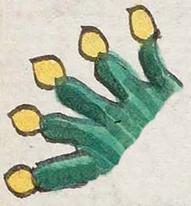malinalli (Mdz35r)
This element for twisted grass (malinalli) has been carved from the compound glyph for the place name Malinalco. In that compound, the grasses are growing out of the top of a skull, hence here they appear to be slanted to the left, and we do not see their roots. There are five blades of grass, and they are painted two tones of green. They have yellow tips, the shape of candle flames.
Stephanie Wood
The skull of the original compound glyph points to death, and this may be explained because, as shown in our Online Nahuatl Dictionary, nopalli malinalli is a diphrasis that stands for blood (owing to the tuna fruit's red juices) and death. The dried malinalli grasses also serve as curative herbs, and they have an association with "the moon, drunkenness, the theluric goddess Cihuacóatl Quilaztli, who is undoubtedly one aspect of witchcraft." [See: Michel Graulich, "Las brujas de las peregrinaciones aztecas," Estudios de Cultural Náhuatl 22 (1992), 87–98, and for this example, see 91.] Malinalli is also a day sign in the tonalpohualli religious divinatory calendar.
Stephanie Wood
c. 1541, but by 1553 at the latest
Xitlali Torres and Stephanie Wood
grasses, medicinal herba, hierbas medicinales

Codex Mendoza, folio 35 recto, https://digital.bodleian.ox.ac.uk/objects/2fea788e-2aa2-4f08-b6d9-648c00..., image 80 of 188.
The Bodleian Libraries, University of Oxford, hold the original manuscript, the MS. Arch. Selden. A. 1. This image is published here under the UK Creative Commons, “Attribution-NonCommercial-ShareAlike 3.0 License” (CC-BY-NC-SA 3.0).



